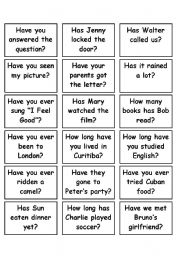


In the third part, you have to look at the image and click on one of 3 sentences. The aim here is to practice making accurate sentences and to test the students on word order and grammar issues. In the second part, you have to look at the image and click on the words to form an accurate perfect tense sentence - for example, 'she has eaten lunch'. The aim of this part is to review the verb forms before starting to make sentences and also to remind/cement the idea that perfect tense uses different verb forms. In the first part, you have to match simple verb forms to their perfect tense conjugations - for example, eat matches to eaten. It is intended to be used by ESL learners to review and reinforce the use of perfect tense. This is a mini-game for practicing perfect tense sentences in English. The sentence still uses 'been' in the phrase contruction part - 'He has been to America'. After a couple of minutes call another time.Updated January 2020 - changed 'been' to 'gone' in the first set of content, so that 'go' now matches to 'gone'. They ask the questions in italics only if their partner answers yes to the first question (emphasize this). The students find their partner for the time and ask the questions for the given time. Elicit the times and pair the students yourself. In the end there will be some people who will not have a partner for one or two of the times.


You may have only one person for each time.In the first part students have to arrange a partner for each time. Print the second page of the worksheet and hand it out. I has been very successful in my classes and it always leads to a lot of speaking in English. The second activity is called Clock speaking. In the last phase students write the sentences about their partner. They listen and tick the activities their partner has done. Then students work in pairs and read their sentences to their partners. (Check that the students form the tense correctly). The students have to write whether they HAVE or HAVE NOT done the activities in the pictures. Print the first exercise and cut it in the middle. It should be used if your students know just how to form the present perfect tense and you want to practise it with them. I have tried both of them in my classes and they worked very well. The following worksheet contains two speaking activities.


 0 kommentar(er)
0 kommentar(er)
